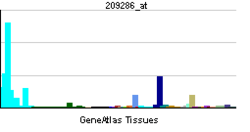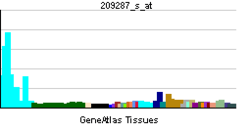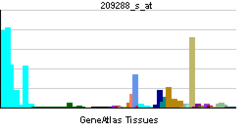CDC42EP3
| CDC42EP3 | |||||||||||||||||
|---|---|---|---|---|---|---|---|---|---|---|---|---|---|---|---|---|---|
| Identifiers | |||||||||||||||||
| Aliases | CDC42EP3, BORG2, CEP3, UB1, CDC42 effector protein 3 | ||||||||||||||||
| External IDs | MGI: 2384718 HomoloGene: 4708 GeneCards: CDC42EP3 | ||||||||||||||||
| |||||||||||||||||
| RNA expression pattern | |||||||||||||||||
   | |||||||||||||||||
| More reference expression data | |||||||||||||||||
| Orthologs | |||||||||||||||||
| Species | Human | Mouse | |||||||||||||||
| Entrez | |||||||||||||||||
| Ensembl | |||||||||||||||||
| UniProt | |||||||||||||||||
| RefSeq (mRNA) | |||||||||||||||||
| RefSeq (protein) | |||||||||||||||||
| Location (UCSC) | Chr 2: 37.64 – 37.74 Mb | Chr 17: 79.33 – 79.36 Mb | |||||||||||||||
| PubMed search | [1] | [2] | |||||||||||||||
| Wikidata | |||||||||||||||||
| View/Edit Human | View/Edit Mouse |
Cdc42 effector protein 3 is a protein that in humans is encoded by the CDC42EP3 gene.[3][4][5]
CDC42, a small Rho GTPase, regulates the formation of F-actin-containing structures through its interaction with the downstream effector proteins. The protein encoded by this gene is a member of the Borg family of CDC42 effector proteins. Borg family proteins contain a CRIB (Cdc42/Rac interactive-binding) domain. They bind to, and negatively regulate the function of, CDC42. This protein can interact with CDC42, as well as with the ras homolog gene family, member Q (ARHQ/TC10). Expression of this protein in fibroblasts has been shown to induce pseudopodia formation.[5]
Interactions
CDC42EP3 has been shown to interact with CDC42[3][6] and RHOQ.[6]
References
- ↑ "Human PubMed Reference:".
- ↑ "Mouse PubMed Reference:".
- 1 2 Alberts AS, Bouquin N, Johnston LH, Treisman R (May 1998). "Analysis of RhoA-binding proteins reveals an interaction domain conserved in heterotrimeric G protein beta subunits and the yeast response regulator protein Skn7". J Biol Chem. 273 (15): 8616–22. doi:10.1074/jbc.273.15.8616. PMID 9535835.
- ↑ Hirsch DS, Pirone DM, Burbelo PD (Mar 2001). "A new family of Cdc42 effector proteins, CEPs, function in fibroblast and epithelial cell shape changes". J Biol Chem. 276 (2): 875–83. doi:10.1074/jbc.M007039200. PMID 11035016.
- 1 2 "Entrez Gene: CDC42EP3 CDC42 effector protein (Rho GTPase binding) 3".
- 1 2 Joberty, G; Perlungher R R; Macara I G (Oct 1999). "The Borgs, a new family of Cdc42 and TC10 GTPase-interacting proteins". Mol. Cell. Biol. UNITED STATES. 19 (10): 6585–97. ISSN 0270-7306. PMC 84628
 . PMID 10490598.
. PMID 10490598.
Further reading
- Joberty G, Perlungher RR, Macara IG (2000). "The Borgs, a new family of Cdc42 and TC10 GTPase-interacting proteins". Mol. Cell. Biol. 19 (10): 6585–97. PMC 84628
 . PMID 10490598.
. PMID 10490598. - Hartley JL, Temple GF, Brasch MA (2001). "DNA cloning using in vitro site-specific recombination". Genome Res. 10 (11): 1788–95. doi:10.1101/gr.143000. PMC 310948
 . PMID 11076863.
. PMID 11076863. - Wiemann S, Weil B, Wellenreuther R, et al. (2001). "Toward a catalog of human genes and proteins: sequencing and analysis of 500 novel complete protein coding human cDNAs". Genome Res. 11 (3): 422–35. doi:10.1101/gr.GR1547R. PMC 311072
 . PMID 11230166.
. PMID 11230166. - Simpson JC, Wellenreuther R, Poustka A, et al. (2001). "Systematic subcellular localization of novel proteins identified by large-scale cDNA sequencing". EMBO Rep. 1 (3): 287–92. doi:10.1093/embo-reports/kvd058. PMC 1083732
 . PMID 11256614.
. PMID 11256614. - Joberty G, Perlungher RR, Sheffield PJ, et al. (2001). "Borg proteins control septin organization and are negatively regulated by Cdc42". Nat. Cell Biol. 3 (10): 861–6. doi:10.1038/ncb1001-861. PMID 11584266.
- Strausberg RL, Feingold EA, Grouse LH, et al. (2003). "Generation and initial analysis of more than 15,000 full-length human and mouse cDNA sequences". Proc. Natl. Acad. Sci. U.S.A. 99 (26): 16899–903. doi:10.1073/pnas.242603899. PMC 139241
 . PMID 12477932.
. PMID 12477932. - Ota T, Suzuki Y, Nishikawa T, et al. (2004). "Complete sequencing and characterization of 21,243 full-length human cDNAs". Nat. Genet. 36 (1): 40–5. doi:10.1038/ng1285. PMID 14702039.
- Ballif BA, Villén J, Beausoleil SA, et al. (2005). "Phosphoproteomic analysis of the developing mouse brain". Mol. Cell Proteomics. 3 (11): 1093–101. doi:10.1074/mcp.M400085-MCP200. PMID 15345747.
- Gerhard DS, Wagner L, Feingold EA, et al. (2004). "The status, quality, and expansion of the NIH full-length cDNA project: the Mammalian Gene Collection (MGC)". Genome Res. 14 (10B): 2121–7. doi:10.1101/gr.2596504. PMC 528928
 . PMID 15489334.
. PMID 15489334. - Wiemann S, Arlt D, Huber W, et al. (2004). "From ORFeome to biology: a functional genomics pipeline". Genome Res. 14 (10B): 2136–44. doi:10.1101/gr.2576704. PMC 528930
 . PMID 15489336.
. PMID 15489336. - Hillier LW, Graves TA, Fulton RS, et al. (2005). "Generation and annotation of the DNA sequences of human chromosomes 2 and 4". Nature. 434 (7034): 724–31. doi:10.1038/nature03466. PMID 15815621.
- Stelzl U, Worm U, Lalowski M, et al. (2005). "A human protein-protein interaction network: a resource for annotating the proteome". Cell. 122 (6): 957–68. doi:10.1016/j.cell.2005.08.029. PMID 16169070.
- Rual JF, Venkatesan K, Hao T, et al. (2005). "Towards a proteome-scale map of the human protein-protein interaction network". Nature. 437 (7062): 1173–8. doi:10.1038/nature04209. PMID 16189514.
- Mehrle A, Rosenfelder H, Schupp I, et al. (2006). "The LIFEdb database in 2006". Nucleic Acids Res. 34 (Database issue): D415–8. doi:10.1093/nar/gkj139. PMC 1347501
 . PMID 16381901.
. PMID 16381901. - Olsen JV, Blagoev B, Gnad F, et al. (2006). "Global, in vivo, and site-specific phosphorylation dynamics in signaling networks". Cell. 127 (3): 635–48. doi:10.1016/j.cell.2006.09.026. PMID 17081983.